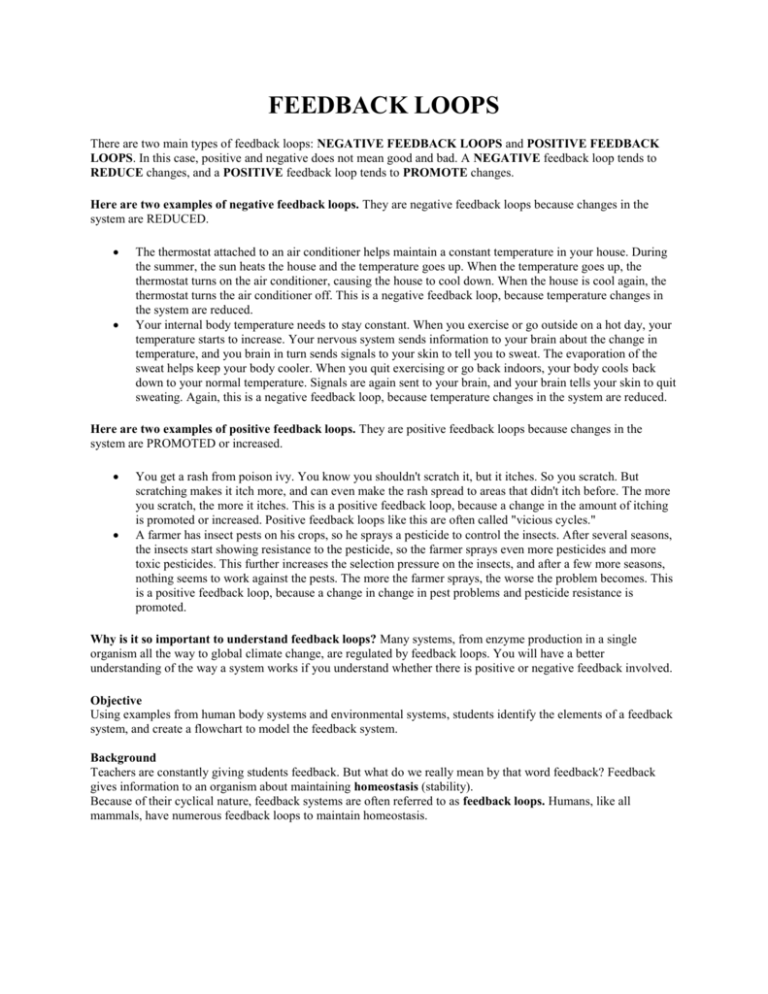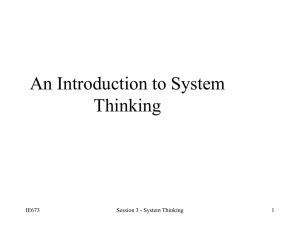feedback loops
advertisement

FEEDBACK LOOPS There are two main types of feedback loops: NEGATIVE FEEDBACK LOOPS and POSITIVE FEEDBACK LOOPS. In this case, positive and negative does not mean good and bad. A NEGATIVE feedback loop tends to REDUCE changes, and a POSITIVE feedback loop tends to PROMOTE changes. Here are two examples of negative feedback loops. They are negative feedback loops because changes in the system are REDUCED. The thermostat attached to an air conditioner helps maintain a constant temperature in your house. During the summer, the sun heats the house and the temperature goes up. When the temperature goes up, the thermostat turns on the air conditioner, causing the house to cool down. When the house is cool again, the thermostat turns the air conditioner off. This is a negative feedback loop, because temperature changes in the system are reduced. Your internal body temperature needs to stay constant. When you exercise or go outside on a hot day, your temperature starts to increase. Your nervous system sends information to your brain about the change in temperature, and you brain in turn sends signals to your skin to tell you to sweat. The evaporation of the sweat helps keep your body cooler. When you quit exercising or go back indoors, your body cools back down to your normal temperature. Signals are again sent to your brain, and your brain tells your skin to quit sweating. Again, this is a negative feedback loop, because temperature changes in the system are reduced. Here are two examples of positive feedback loops. They are positive feedback loops because changes in the system are PROMOTED or increased. You get a rash from poison ivy. You know you shouldn't scratch it, but it itches. So you scratch. But scratching makes it itch more, and can even make the rash spread to areas that didn't itch before. The more you scratch, the more it itches. This is a positive feedback loop, because a change in the amount of itching is promoted or increased. Positive feedback loops like this are often called "vicious cycles." A farmer has insect pests on his crops, so he sprays a pesticide to control the insects. After several seasons, the insects start showing resistance to the pesticide, so the farmer sprays even more pesticides and more toxic pesticides. This further increases the selection pressure on the insects, and after a few more seasons, nothing seems to work against the pests. The more the farmer sprays, the worse the problem becomes. This is a positive feedback loop, because a change in change in pest problems and pesticide resistance is promoted. Why is it so important to understand feedback loops? Many systems, from enzyme production in a single organism all the way to global climate change, are regulated by feedback loops. You will have a better understanding of the way a system works if you understand whether there is positive or negative feedback involved. Objective Using examples from human body systems and environmental systems, students identify the elements of a feedback system, and create a flowchart to model the feedback system. Background Teachers are constantly giving students feedback. But what do we really mean by that word feedback? Feedback gives information to an organism about maintaining homeostasis (stability). Because of their cyclical nature, feedback systems are often referred to as feedback loops. Humans, like all mammals, have numerous feedback loops to maintain homeostasis. Our physiological feedback systems have three key features: 1. A receptor that can evaluate the stimulus (change in environment) and sends a message to… 2. An integrating center (Brain) that processes the information and sends a message to… 3. An effector that acts on the stimulus and causes a response (reaction) in the organism. Feedback Loops Activity You will be looking at a series of physiological and ecological scenarios. For each one you will be doing the following: 1. Read the example of the homeostatic mechanism. 2. Determine if it is a case of positive or negative feedback. 3. Identify the following in the example you are given and list the structures they are associated with. a. Stimulus b. Receptor c. Integrating center d. Effector e. Response 4. Create a flow chart similar to the one below using the structures that you have identified in your given mechanism Problem #1: When you become dehydrated, and the osmolality of the blood increases (meaning your blood has more salt and less water), osmoreceptors in the hypothalamus cause the posterior pituitary to secrete anti-diuretic hormone (ADH). ADH acts on the kidney to increase the reabsorption of water, and put the water back into your bloodstream. This helps prevent the osmolality of the blood from increasing even further. If you drink lots of water, ADH production decreases, and the kidneys remove water from the blood, again maintaining the osmolality of the blood. Is this a positive or negative feedback loop? Problem #2: During childbirth, the fetus is pushed against the uterine opening, causing it to stretch. Receptors that detect the stretching send signals to the brain. The brain sends both neural and hormonal signals which increase both the contraction force and the contraction frequency in the smooth muscles of the uterus. This continues until the baby is delivered through the birth canal. Is this a positive or negative feedback loop? Problem #3: An increase of carbon dioxide in the blood leads to a decrease in blood pH. The drop in blood pH is detected by chemoreceptors in the aorta and carotid artery. These receptors send nerve impulses to the respiratory center in the medulla oblongata in the brain, which then stimulates increased breathing. Increased breathing helps remove carbon dioxide from the blood, returning blood pH to normal levels. Is this a positive or negative feedback loop? Problem #4: After eating a meal, your blood glucose level increases. Islet cells in your pancreas detect the rise in blood sugar, and release insulin into the bloodstream. Insulin binds to receptors on cells throughout the body, allowing the cells to take up glucose from the blood. This lowers blood glucose levels back to a normal level. Is this a positive or negative feedback loop? Problem #5: As a follicle develops in the female ovary, it releases estradiol into the blood. Estradiol stimulates the anterior pituitary to secrete luteinizing hormone (LH), which further stimulates the developing follicle and therefore the production of estradiol. This cycle continues until the follicle ruptures, releasing the egg into the fallopian tube. Is this a positive or negative feedback loop? Problem #6: When thyroxine levels in the body are low, the hypothalamus secretes thyrotropin-releasing hormone (TRH). TRH acts on the anterior pituitary causing the secretion of thyroid-stimulating hormone (TSH). TSH, in turn, acts on the thyroid gland, causing secretion of thyroxine. Increased levels of thyroxine act on both the hypothalamus and anterior pituitary, decreasing the release of both TRH and TSH. Is this a positive or negative feedback loop? Problem #7: Here are some examples related to ecosystems and global climate change. Ice caps at the north and south poles are very reflective -- the ice reflects light and heat rather than absorbing it. If global warming occurs, then the increase in temperature will cause polar ice to melt, and the bare dark ground will absorb rather than reflect heat. This additional absorption of heat will further boost the temperature of the earth. Is this a positive or negative feedback loop? Problem #8: Carbon dioxide is considered a "greenhouse gas" since it absorbs heat that would otherwise dissipate out into space. If there is more carbon dioxide in the atmosphere, global temperatures are likely to increase. It is possible that plants will respond to the increased carbon dioxide and increased temperatures with an increase in photosynthesis. Since carbon dioxide is needed for photosynthesis, this could reduce the amount of carbon dioxide in the atmosphere, leading to cooler temperatures. Is this a positive or negative feedback loop? Problem #9: We know that warm water holds less dissolved gas -- that's why a soda pop goes flat when it gets warm. Normally, there is a great deal of dissolved carbon dioxide in cold ocean water. If global warming occurs and global temperatures increase, warmer ocean water will hold less dissolved carbon dioxide. Less dissolved carbon dioxide in the ocean means more carbon dioxide in the atmosphere. Since carbon dioxide is a "greenhouse gas," the increase in atmospheric carbon dioxide will further boost global temperatures, making it even warmer. Is this a positive or negative feedback loop?








